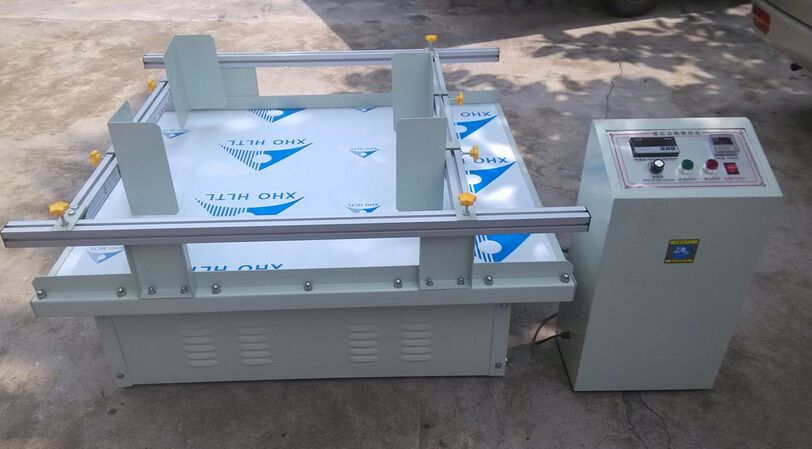ISO 13355 Vibration Testing for Distribution
The ISO 13355 vibration testing standard is specifically designed to evaluate packaging systems under simulated transportation conditions. This test ensures that products can withstand the environmental stresses encountered during shipping and handling, thereby protecting product integrity and minimizing damage during distribution.
During ISO 13355 vibration testing, specimens are subjected to controlled levels of random vibrations in both vertical and horizontal planes. These vibrations mimic the dynamic forces experienced by packages as they travel through various modes of transport such as trucks, trains, ships, and airplanes. The test is crucial for ensuring that packaging can protect contents under a range of environmental conditions including temperature fluctuations, humidity, and pressure changes.
Testing typically involves placing samples into representative shipping containers or crates and subjecting them to a series of sinusoidal vibrations at specified frequencies and amplitudes. The duration and amplitude levels are determined by the specific transportation requirements of the product being tested. This ensures that packaging solutions meet the necessary standards for protection during transit.
For accurate testing, it is essential to follow the guidelines outlined in ISO 13355. Compliance with these specifications guarantees reliable test results and helps ensure that packaging will perform effectively under real-world conditions. The test provides data on how well a package can absorb shocks and vibrations without compromising the product inside.
The process of preparing specimens for testing includes selecting appropriate containers or crates, ensuring they are representative of actual shipping conditions, and securing the sample within the container to prevent shifting during vibration. Once prepared, the specimen is placed in an environmental chamber where it undergoes controlled exposure to vibrations based on predefined parameters.
The results of ISO 13355 testing provide critical insights into the effectiveness of packaging designs for protecting products throughout their supply chain journey. By identifying potential weaknesses early on, manufacturers can make necessary adjustments before mass production begins. Additionally, this testing helps companies meet regulatory requirements and industry standards associated with safe and efficient transportation.
Understanding the nuances of ISO 13355 vibration testing allows quality managers, compliance officers, R&D engineers, and procurement professionals to better manage their supply chains by ensuring that packaging meets all necessary criteria for protecting products during shipment. Properly conducted tests not only enhance product safety but also contribute significantly to reducing waste associated with damaged goods.
- Real-world application: Packaging designed according to ISO 13355 standards has been shown to reduce damage rates by up to 40%, leading to cost savings for companies and improved customer satisfaction.
- Regulatory compliance: Many industries, including pharmaceuticals, electronics, and food products, require packaging that meets these stringent testing protocols to ensure product safety during transport.
Benefits
The benefits of ISO 13355 vibration testing extend beyond just ensuring physical protection; they also contribute to broader business goals related to quality assurance, cost management, and regulatory compliance. Here are some key advantages:
- Enhanced Product Integrity: By subjecting packaging to simulated transport conditions early in the design phase, companies can identify potential issues before full-scale production begins.
- Cost Reduction: Early detection of flaws through rigorous testing helps prevent costly rework and recalls later down the line. Additionally, optimized packaging reduces shipping costs by minimizing weight and volume without compromising protection.
- Improved Customer Satisfaction: Packages that pass ISO 13355 tests are less likely to suffer damage during transit, leading to happier customers who receive their products in pristine condition.
- Compliance Assurance: Meeting these international standards demonstrates a commitment to high-quality practices and helps companies stay ahead of evolving regulations across different markets.
Why Choose This Test
- Detailed Insights: Get comprehensive data on packaging performance under simulated transportation conditions, helping you make informed decisions about design improvements.
- International Recognition: Adherence to ISO standards ensures your testing results are universally accepted and recognized by industry stakeholders worldwide.
- Cost Efficiency: Early identification of potential issues through thorough testing can lead to significant reductions in waste, rework, and recall costs.
- Regulatory Compliance: Stay ahead of regulatory changes by ensuring your packaging meets all necessary criteria for protecting products during shipment.
International Acceptance and Recognition
The ISO 13355 vibration testing standard enjoys widespread acceptance across numerous industries, making it an essential tool for companies operating internationally. Its broad applicability ensures that packaging solutions are robust enough to handle the diverse challenges posed by global supply chains.
Many reputable organizations and regulatory bodies recommend compliance with ISO 13355 as a best practice in packaging design. This recognition underscores its importance in maintaining high-quality standards across various sectors, including pharmaceuticals, electronics, and food products.
By leveraging this internationally accepted standard, businesses can ensure that their packaging meets the highest quality benchmarks, thereby enhancing product protection during transportation while also demonstrating a commitment to excellence within the industry.





